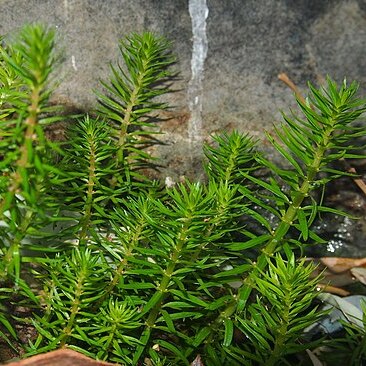Creeping aquatic or palustrine herbs to 3 dm. tall, the branches obscurely angular. Leaves ternate, the submerged leaves linear, 3-18 mm. long, 0.5-3.0 mm. wide, the emersed leaves 3-8 mm. long, 1-2 mm. wide, both obtuse or retuse, cuneate-attenuate at the base. Flowers sessile, subtended by 2 setose bracteoles. Hypanthium urceolate, 0.6-1.0 mm. long, 0.5-0.6 mm. broad at the orifice; calyx lobes narrowly deltoid, sometimes unequal. Petals absent. Stamens commonly 2, the anthers oblong-ovoid, about 0.1 mm. long, 0.25 mm. wide, the filaments about 0.4 mm. long. Ovary globose, abruptly narrowed into a short gynophore, 0.4 mm. long; style about 0.1 mm. long. Seeds suborbicular, about 0.3 mm. long, 0.25 mm. wide.
Herbs, annual, aquatic, amphibious, or terrestrial. Stem 3-10 cm, creeping, floating, or erect and ascending, branching. Leaves 3-5(-8)-whorled; aerial leaves narrowly lanceolate to broadly linear [or ovate], 5-10 × 1.5-2 mm, base narrow, apex truncate and often 2-cleft; submerged leaves linear, to 15 × 0.5 mm. Flowers solitary, sessile, axillary; bracteoles linear, ca. as long as floral tube. Floral tube (3 or)4(or 5)-merous, campanulate, translucent, ca. 0.5 mm; sepals (3 or)4(or 5); epicalyx absent. Petals absent. Stamens (1 or)2 or 3(or 4), included. Ovary subglobose; style included, much shorter than ovary. Capsule ca. 1 mm in diam., (2 or)3-valved. Seeds ca. 0.3 mm. Fl. Sep-Dec.
Annual herb to 8 cm tall. Stems creeping, ascending, erect or floating, simple or branched. Leaves decussate or in whorls of 3-8, sessile; aerial leaves linear to lanceolate or ovate, to 13 mm long; aquatic leaves linear, to 15 mm long. Bracts leaf-like or obspathulate, usually truncate, often crowned with 2 points; bracteoles filamentous or linear-lanceolate, usually as long as hypanthium rarely to twice the length. Hypanthium semi-globose, to 1 mm long; appendages absent. Sepals 3-5, usually 5, triangular, to 0.5 mm long. Petals absent. Stamens 2-4, usually 3, inserted near base of hypanthium. Capsule globose, c. 1 mm diam., opening by 3 valves.
Annual herb. Leaves in whorls of 3-5(-8). Petals absent. Stamens (1)2(4). Capsule 3-valved, as long as calyx tube.


